
Instruction
Manual
Impulse Force Hammers
Types 9722A(X),
9724A(X),
9726A(X),
9728A20000
and Accessories
ä
002-082e-01.01
(B08.014e)

Page 1
B08.014e-01.01
Operating Instructions
Impulse Force Hammers
Types 9722A(X), 9724A(X), 9726A(X), 9728A20000
And Accessories
Kistler Instrument Corp., 75 John Glenn Drive, Amherst, NY 14228, USA
Phone (716) 691-5100, Fax (716) 691-5226, E-mail [email protected]
Kistler Instrumente AG Winterthur, Postfach 304, CH-8408 Winterthur, Switzerland
Phone (052) 224 11 11, Fax (052) 224 14 14, E-mail [email protected]

Type 97XX Impulse Force Hammers Page 2
B08.014e-01.01
Contents
Section Page
Contents............................................................................................................................................2
1. Introduction ..................................................................................................................................3
1.1 Applicable Products....................................................................................................3
1.2 Purpose of Impact Testing..........................................................................................3
1.3 Why Impact Excitation? ..............................................................................................3
2. Product Description.....................................................................................................................4
3. Operation ......................................................................................................................................5
3.1 General .......................................................................................................................5
3.2 Powering and Signal Conditioning..............................................................................5
3.2.1 Using "Built-in" Power Sources...................................................................................5
3.2.2 Kistler Couplers...........................................................................................................5
3.3 Tailoring the Hammer .................................................................................................7
3.3.1 Tip Selection and Installation......................................................................................7
3.3.2 Using the Extension Mass. .........................................................................................10
4. Measurement Techniques...........................................................................................................11
5. Maintenance and Calibration......................................................................................................12
5.1 General .......................................................................................................................12
5.2 Trouble Shooting.........................................................................................................12
5.3 Repairs........................................................................................................................13
5.4 Cleaning......................................................................................................................13
5.5 Calibration...................................................................................................................13
6. Technical Data..............................................................................................................................13
7. Warranty........................................................................................................................................15

Type 97XX Impulse Force Hammers Page 3
B08.014e-01.01
1. Introduction
By choosing this Kistler quality product you have opted for an instrument
distinguished by precision, long life and technical innovation. Please read
these operating instructions carefully. You will then make the best use of
the versatile capabilities of your quartz impulse hammer. Kistler offers a
wide selection of measuring instruments and all-embracing systems.
• Quartz sensors for force, pressure, strain, acceleration, shock
and vibration.
• Associated signal conditioners and calibrators.
• Electronic control, display and evaluation instruments.
• Piezoresistive pressure transducers and transmitters with
associated signal conditioning.
Kistler can also provide entire measuring systems for special applications
as in the automotive industry, plastics processing and biomechanics. Our
general catalog provides technical information on the general product line.
Individual detailed technical data sheets are available on virtually every
Kistler product.
Worldwide Kistler customer service is at your disposal for any special
questions still open after studying these instructions. Expert advice is
available on your specific application.
1.1 Applicable Products
This manual covers the following impact hammers:
9722A, 9724A, 9726A, 9728A
The impact hammer, along with the appropriate accessories, is supplied
in a convenient carrying case. If a kit was ordered that included couplers,
accelerometers, or other optional accessories, these components are
also included in the case. This manual does not provide information on
the optional accessory items. Please refer to the accessory operating
manuals included with the shipment.
1.2 Purpose of Impact Testing
Impact hammers are used to provide broadband structural excitation
when measuring the frequency response function of a mechanical
system. The pulse produced by the impact provides input energy with a
nearly constant amplitude over the selected frequency range as
determined by the hammer tip and structure under test.
1.3 Why Impact Excitation?
During the past decade, the popularity of impact testing for structural
dynamics testing has grown enormously. When used properly, accurate
results can be obtained in a very easy and convenient way. Very little
hardware is required and the equipment is portable and relatively
inexpensive. Set-up time is reduced since there are no shaker, amplifier
and electronics to set-up at each input point. Since a hammer permits
easier access to hard to reach areas, innovative testing is possible.

Type 97XX Impulse Force Hammers Page 4
B08.014e-01.01
2. Product Description
Kistler offers hammer kits in four sizes and with a variety of force ranges
(see page 14). The user should select the hammer size that is suitable for
the application and has enough mass to excite the structure under study.
Figure 1A: Type 9722A used to excite light to medium structures at
medium to high frequencies, such as disc brakes and
small motors.
Figure 1B: Type 9724A is for testing medium structures at medium
to high frequencies, such as small machinery, aerospace
and automotive structural parts.
Figure 1C: Type 9726A is for testing medium to heavy structures at
low to medium frequencies, such as medium machinery,
mechanical assemblies and vessels or tanks.
Figure 1D: Type 9728A is ideal for testing heavier structures at low
frequencies, such as large machine tools, I-beams and
building structures.

Type 97XX Impulse Force Hammers Page 5
B08.014e-01.01
2. Product Description (Continued)
The carrying case (Figure 1) is designed to hold and transport the
hammer kit, accessories and optional equipment. It is recommended that
the supplied equipment be stored in the case when being transported or
when not in use.
A BNC connector, on the end of the handle is used for signal output and
the load cell (force transducer) power.
3. Operation
3.1 General
Set-up and operation of Kistler impact hammers is easy. They can be
operated directly from nearly all FFT analyzers with built-in accelerometer
power (2...18 mA, Piezotron voltage mode piezoelectric style). A variety
of Kistler couplers are available to power and provide input signal
conditioning.
Multi-channel couplers can be used to power both the impact hammer
and measuring accelerometers. The reader should read the following
operating instructions to ensure satisfactory results.
3.2 Powering and Signal Conditioning
3.2.1 Using "Built-in" Power Sources
Many FFT analyzers and modal analysis systems are available with
internal accelerometer power supplies that provide a convenient means of
operating Kistler hammer kits. The hammer can generally be connected
directly to the input of the FFT without the need for any further signal
conditioning or additional power sources.
The hammers require a constant current supply in the range of 2 ...18
mA. It is recommended that 4 mA be used unless the cable length
exceeds 430 feet (130 meters). Contact Kistler should information on long
cables be required.
3.2.2 Kistler Couplers
Kistler offers a comprehensive line of low noise power supply/couplers for
modal analysis. These couplers can be used with Kistler hammers and
nearly all accelerometers with built-in impedance converters. The power
supply/couplers are variously known as constant current source supplies
or ICP power supplies. The industry also recognizes these couplers as
voltage mode piezoelectric units by the designation Integral Electronic
PiezoElectric (IEPE).
The chart on the following page provides a listing of available power
supplies/couplers. Please request data sheets on specific types.

Type 97XX Impulse Force Hammers Page 6
B08.014e-01.01
Type 5108A Passive coupler. Customer provides power. CE approved
Type 5110 Battery powered single channel coupler with banana
plugs for direct connection to a multimeter and BNC
connection. CE approved
Type 5114 AC/battery powered single channel coupler with LCD
display to monitor bias. LED’s indicate status of sensor
circuit. Portable or table-top use. CE approved
Type 5118B2 AC/battery powered single channel coupler with 1X, 10X,
100X gain and high pass filter switch. CE approved
Type 5134A 4-channel AC powered coupler and amplifier. Selectable
high pass filters and gain. Random noise generator for
testing with FFT analyzer. Remote control and sensing
via RS-232C. CE approved
Type 5148 16-channel rack mountable AC powered coupler with
unity gain. LED’s indicate circuit integrity. Front panel
BNC output connectors.
Type 5350 Sensor simulator for trouble shooting or checking system
performance. It provides an ideal means to confirm
sensor location or detect inoperative cables. Connects
directly to the input of any Kistler coupler or any power
supply/coupler variously known as a constant current
supply or ICP power supply. Output frequencies of 100 Hz
or 1000 radians/second, sine or square wave with
adjustable amplitude.
Table 1: Kistler Power Supplies/Couplers and Accessories
Figure 2: Kistler Type 5114 Coupler is One of Several
Units Designed to Operate with Impuse Force Hammers

Type 97XX Impulse Force Hammers Page 7
B08.014e-01.01
3.3 Tailoring the Hammer
The impact hammer consists of the hammer structure with a stainless
steel head and a piezoelectric force transducer (load cell). An internal
circuit Piezotron impedance converter provides a low impedance, voltage
output. A variety of interchangeable tips and a detachable extender mass
are also included. Refer to previous Figure 1A to Figure 1D which show
the different hammer configurations and accessories.
3.3.1 Tip Selection and Installation
The frequency content of the applied energy depends on the stiffness of
contacting surfaces. The stiffness can be easily controlled by the type of
hammer tip selected. A hard tip produces a shorter duration pulse, (see
Figure 3) thus applying energy to higher frequencies. To obtain the best
test results it is important not to excite modes outside the frequency range
of interest. As a guideline, the roll-off characteristics of the impact force
spectrum should be such that -10 dB to -20 dB attenuation occurs at the
maximum frequency of interest. Table 2 provides information as to the
frequency response of the supplied tips. (A frequency domain plot is
provided for the 9722A, 9724A, 9726A and the 9728A hammers to
provide more detailed tip frequency response information).
Figure 4A: Frequency Domain Plot of 9722A(X) Hammer With Various Tips
Figure 3: Pulse Shapes For
Various Tip Hardnesses

Type 97XX Impulse Force Hammers Page 8
B08.014e-01.01
Figure 4B: Frequency Domain Plot of 9724A(X) Hammer With Various Tips
Figure 4C: Frequency Domain Plot of 9726A(X) Hammer With Various Tips
Figure 4D: Frequency Domain Plot of 9728A(X) Hammer With Various
TipsThe tips and tip adapters screw into the load cell end of the hammer

Type 97XX Impulse Force Hammers Page 9
B08.014e-01.01
(Figure 5). The larger tips can be installed using the hand. A wrench
(Kistler type 1370) is supplied to install the smaller tips. The tips should
be tightened to insure that there is no motion between the tip and load
cell. See table for recommended maximum torque. Do not over tighten.
Tip type 9906 is simply a cover for the 9904A tip that provides a longer
duration pulse. Simply slide the 9906 over the 9904A tip when required.
Never use the hammer without a tip. Operation without a tip may
damage the load cell surface and may affect performance.
Impulse Hammer Type
Type/Spec.
Material
Mass
(g)
Color Torque
in-lbs
(Nm)
9722
9724
9726
9728
9902A Stainless Steel 2.4 20 (2.3)
Frequency Response, Hz
Without Extender 9000 6800 5200 N/A
With Extender 7500 5500 4600 N/A
9904A Stainless Steel 2.0 20 (2.3)
Frequency Response, Hz
Without Extender 2600 2000 1500 N/A
With Extender 2100 1600 1300 N/A
9906 PVC 2.2* Black 20 (2.3)
Frequency Response, Hz
Without Extender 1800 1400 1100 N/A
With Extender 1500 1300 1000 N/A
9908 Plastic 37** Green 20 (2.3)
Frequency Response, Hz (Hard)
Without Extender 1100 800 600 N/A
With Extender 900 650 500 N/A
9910 Plastic 36** Red 20 (2.3)
Frequency Response, Hz (Medium)
Without Extender 650 500 400 N/A
With Extender 550 400 300 N/A
9912 Plastic 34** Gray 20 (2.3)
Frequency Response, Hz (Soft)
Without Extender 450 350 250 N/A
With Extender 350 300 200 N/A
9914 Plastic 40 Black 20 (2.3)
Frequency Response, Hz (Hard)
Without Extender N/A N/A N/A 900
With Extender N/A N/A N/A 700
9916 Plastic 40 Green 20 (2.3)
Frequency Response, Hz (Medium)
Without Extender N/A N/A N/A 600
With Extender N/A N/A N/A 500
9918 Plastic 40 Gray 20 (2.3)
Frequency Response, Hz (Soft)
Without Extender N/A N/A N/A 300
With Extender N/A N/A N/A 250
Table 2: Hammer Tip Characteristics
Frequency range may vary depending on application
* Includes weight of 9904A
** Includes weight of 9228 adapter

Type 97XX Impulse Force Hammers Page 10
B08.014e-01.01
3.3.2 Using the Extension Mass
The amount of energy applied to a structure is the product of the hammer
mass and the hammer velocity. Since it is difficult to control the velocity of
the hammer, the total hammer mass can be easily controlled. Each
hammer is supplied with an extender mass that screws on the top of the
hammer head to add extra energy when required.
To install the extender mass, simply screw the stud into the top of the
hammer head. The extender mass should be tightened by hand with just
enough torque to ensure that it will not come loose during testing.
Do not over tighten.
Hammer Type Extension Mass
Type Number Weight of Extension Mass
(grams)
9722A 9922 50
9724A 9924 125
9726A 9926 250
9728A 9930 750
Table 3: Extension Mass Type Numbers and Weight
Figure 5: Typical Impulse Force Hammer

Type 97XX Impulse Force Hammers Page 11
B08.014e-01.01
4. Measurement Techniques
Proper techniques will lead to more accurate results. If this is the first time
use of an instrumented hammer, the user should be familiar with the
limitations and techniques covered in the many papers on this topic. The
following information is provided to serve as a measurement and pre-
measurement check list.
When collecting data, use the time domain display on the analyzer and
watch for the following:
• Double hits. These are often caused by the hammer bouncing off the
measurement surface. They will appear as multiple pulses on the
analyzer's input time display.
• Watch signal amplitude. Make sure it is adequate to excite the
structure but does not overload the analyzer input. Many FFT
analyzers have a light indication of an overload condition or reject
data when an input overload is present.
• Attempt to match the hammer output voltage to the analyzer input
such that levels are between half and full scale of the analyzer's
range.
• Check the response channels to ensure adequate signal amplitude
without overloads. Again, maximize use of the analyzer input range.
• Use the proper weighting functions. Also use of the improper function
(i.e., Hanning) can cause gross errors in the measurement results.
Use a "Force Window" in the input channel and an "Exponential
Window" in the response channels. Follow the instructions in the FFT
manual for recommended settings of the respective windows. Correct
use of these windows will result in accurate, low noise data. These
window functions are found on most modern FFT/Modal analyzers.
• Take at least four frequency domain averages of the transfer function.
• Check to ensure a coherence >0.9 within the frequency range of
interest.
• Confirm the calibration of the measurement system by using a signal
calibrator-simulator such as the Kistler 5350.
5. Maintenance and Calibration
5.1 General
5.2 Trouble Shooting
Do not try to remove the force sensor from the hammer. This action may
damage the sensor.

Type 97XX Impulse Force Hammers Page 12
B08.014e-01.01
Should the user experience any problems with the hammer load cell or a
Piezotron accelerometer (sensor), the following procedure should be
followed.
Check for possible intermittent cables. Faulty cables are the most
common cause of piezoelectric measurement problems. The application
of a test signal at the hammer end of the cable is an effective means to
determine if the problem is sensor, cable or measurement instrument
related. An instrument such as the Kistler Transducer Simulator type 5350
is ideal for this test.
Kistler couplers are equipped with a bias monitor which can be used to
check the cable integrity and detect malfunctions in the measurement
sensor. Use the bias monitor as follows:
I. With the sensor connected, check for a normal reading on the
bias indicator (normal is approximately 11 VDC).
II. If the bias reading is high:
A. Disconnect the sensor at the sensor end of the cable and
short the cable connector.
B. If the bias indicator reading stays high, replace the cable.
C. If the bias indicator reading now reads low, replace the
sensor.
III. If the bias indicator reads low, disconnect the sensor:
A. If the bias indicator still reads low, replace the cable.
B. If the bias level changes when the sensor is disconnec-
ted, the sensor is defective.
FFT analyzers with built-in sensor power sources generally do not have
bias monitors. In these cases, the user can attach a T connector to the
FFT analyzer and measure the actual bias voltage using an accurate DC
Voltmeter. If the system is operating properly, the bias voltage should
measure approximately 11 Volts. Defects should show-up as in Items II.
and III. above.
If it is determined that the sensor requires repair, please contact Kistler or
your local distributor/representative for repair information.
5.3 Repairs
Field repair is not possible. Please return the instrument to the factory
together with a statement of problems encountered and unit serial
number. Recalibration is recommended when returning a sensor to the
factory. Please contact Kistler for a return authorization number prior to
return.
5.4 Cleaning
When cleaning the sensor, use isopropyl alcohol and lint-free wipes.
Never use air-blast to clean the connector; it may deposit a vapor film.
5.5 Calibration
Specialized force calibration equipment is required to calibrate the
hammer sensor. It is recommended that the hammer be returned to
Kistler when calibration is required. Kistler acceptance test

Type 97XX Impulse Force Hammers Page 13
B08.014e-01.01
instrumentation is in conformance with MIL-STD-45662A. A calibration
certificate will be supplied showing calibration results traceable to NIST.
6. Technical Data
Specifications for the impact hammers are listed in this section on the
next page. Please refer to individual instruction manuals for optional
accessories when ordering complete hammer kits.

Type 97XX Impulse Force Hammers Page 14
B08.014e-1.01
Specification Units 9722A 500 9722A 2000 9724A 2000 9724A 5000 9726A 5000 9726A 20000 9728A 20000
Force Range (For 5V Output) N (lbf) 500 (100) 2000 (500) 2000 (500) 5000 (1000) 5000 (1000) 20000 (5000) 20000 (5000)
Overload Capacity % 500 500 500 250 250 25 25
Hammer Sensitivity, nom. mv/N (mV/lbf) 10 (50) 2 (10) 2 (10) 1 (5) 1 (5) 0.2 (1) 0.2(1)
Resonant Frequency kHz 27 27 27 27 27 27 20
Hammer Mass (head) g (lb) 100 (0.2) 100 (0.2) 250 (0.5) 250 (0.5) 500 (1.1) 500 (1.1) 1500 (3)
Maximum Frequency , -10dB
Without Extender Hz 8200 9300 6600 6900 5000 5400 1000
With Extender Hz 7000 7700 5400 5500 4500 4700 900
Rigidity kN/μm 0.8 0.8 0.8 0.8 0.8 0.8 2.7
lbf/μin 4.8 4.8 4.8 4.8 4.8 4.8 15.4
Table 4: Impact Hammer Specifications
Common Specifications:
Time Constant, nom. 500 sec.
Temperature Range: -20°C...70°C
Sealing Case/Connector: Welded/Epoxy

Type 97XX Impulse Force Hammers Page 15
B08.014e-01.01
7. Warranty
The Kistler Instrument Corporation warrants all Kistler products to be free
from defects in material and workmanship. All such products are
warranted only under normal use and service.
The impact hammers described herein are warranted for a period of 12
months from date of shipment. For cables and adapters the warranty
period is also 12 months.
When returning items under warranty, said equipment shall be returned to
Kistler prepaid. Full details relative to the claim of malfunction shall
accompany the shipment. No action will be taken until these details are
received. Please contact Kistler for a RETURN AUTHORIZATION (RA)
number before returning goods.
Settlement will be made at Kistler's discretion, either through repair or
replacement of the item in question or through issuance of full credit.
Damage occurring through misuse or mishandling, will not be covered by
this warranty.
This warranty is in lieu of all warranties expressed or implied and of all
obligations or liabilities on the part of Kistler Instrument Corporation for
damages following the use or misuse of items supplied. Any unauthorized
disassembly or attempt at repair, shall void this warranty.
No agent or representative is authorized to assume for the corporation
any liability except as set forth within this warranty document.
Our responsibility under the warranty is strictly restricted to the above
provisions and we specifically decline any liability for damages incurred
consequent upon the use or operation of our equipment.

Type 97XX Impulse Force Hammers Page 16
B08.014e-01.01
ERRATA
Types 9722, 9724, 9726, 9728, if subjected to operating
conditions including radio-frequency current in the cabling, may
be affected by higher than normal moise levels on the output
signal.
Several remedial actions, such as the addition of ferrite chokes to
the cable, may be utilized to alleviate this condition.

Disposal Instructions
for Electrical and Electronic Equipment
Do not discard old electronic instruments in municipal trash.
For disposal at end of life, please return this product to an
authorized local electronic waste disposal service or contact
the nearest Kistler Instrument sales office for return instruc-
tions.
©2005 , Kistler Instrumente AG, PO Box, Eulachstr. 22, CH-8408 Winterthur
Tel +41 52 224 11 11, Fax 224 14 14, info@kistler.com, www.kistler.com
This information corresponds to the current state of knowledge. Kistler reser-
ves the right to make technical changes. Liability for consequential damage
resulting from the use of Kistler products is excluded.
002-331e-09.05

-
 1
1
-
 2
2
-
 3
3
-
 4
4
-
 5
5
-
 6
6
-
 7
7
-
 8
8
-
 9
9
-
 10
10
-
 11
11
-
 12
12
-
 13
13
-
 14
14
-
 15
15
-
 16
16
-
 17
17
-
 18
18
-
 19
19
Kistler 9726A5000 Owner's manual
- Type
- Owner's manual
- This manual is also suitable for
Ask a question and I''ll find the answer in the document
Finding information in a document is now easier with AI
Related papers
-
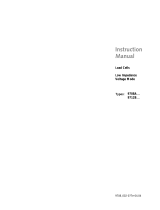 Kistler 9712B250 Owner's manual
Kistler 9712B250 Owner's manual
-
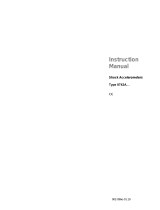 Kistler 8742A Series Owner's manual
Kistler 8742A Series Owner's manual
-
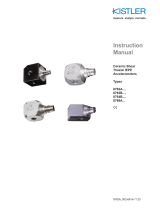 Kistler 8764B250AB Owner's manual
Kistler 8764B250AB Owner's manual
-
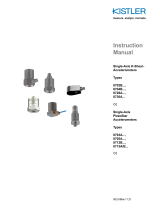 Kistler 8704B25M1T Owner's manual
Kistler 8704B25M1T Owner's manual
-
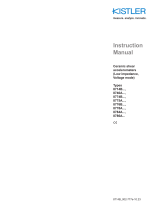 Kistler 8774B100SSP Owner's manual
Kistler 8774B100SSP Owner's manual
-
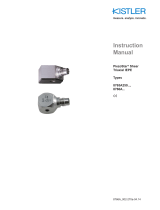 Kistler 8768A100BB Owner's manual
Kistler 8768A100BB Owner's manual
-
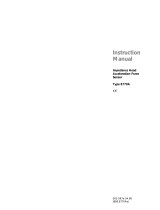 Kistler 8770A50 Owner's manual
Kistler 8770A50 Owner's manual
-
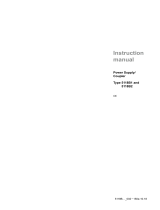 Kistler 5118B2 Owner's manual
Kistler 5118B2 Owner's manual
-
 Kistler 5108A Owner's manual
Kistler 5108A Owner's manual
-
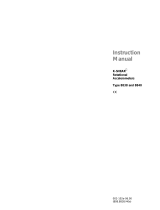 Kistler 8838 Owner's manual
Kistler 8838 Owner's manual




























